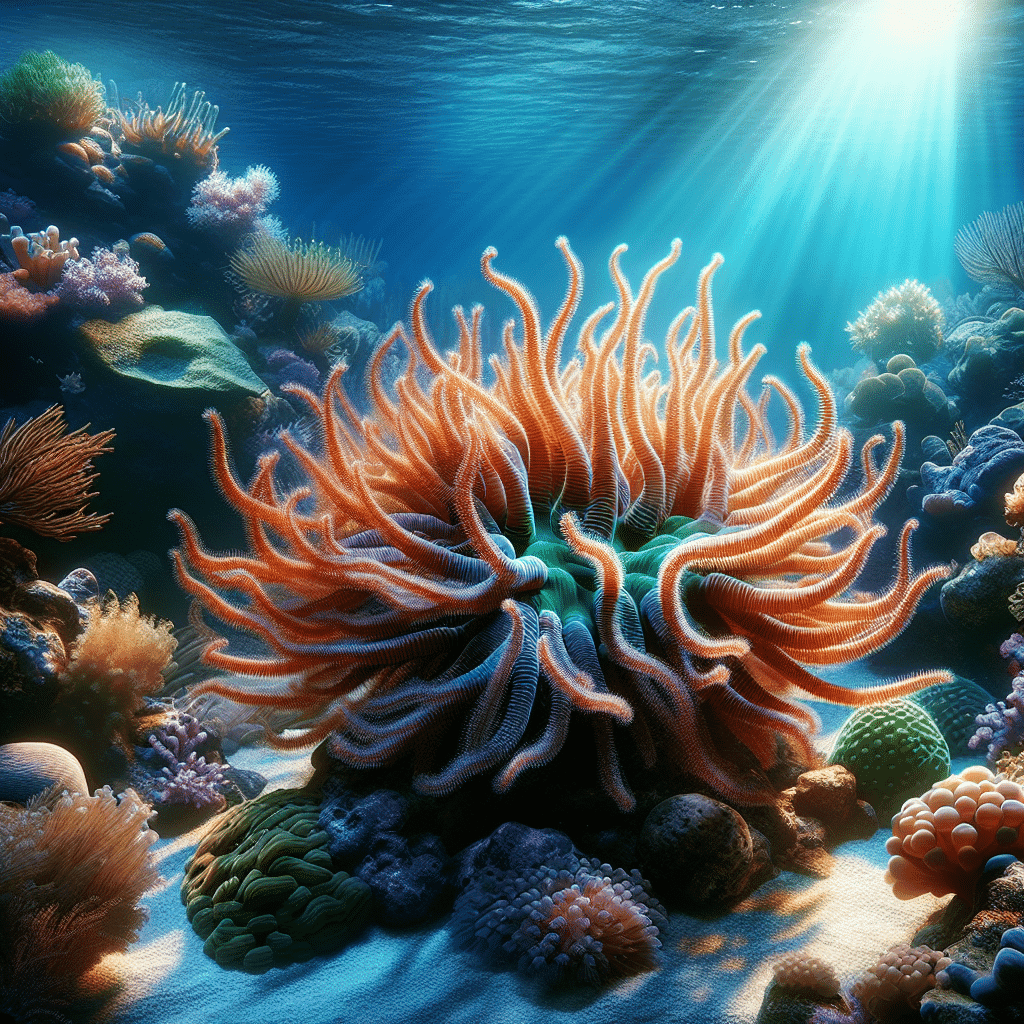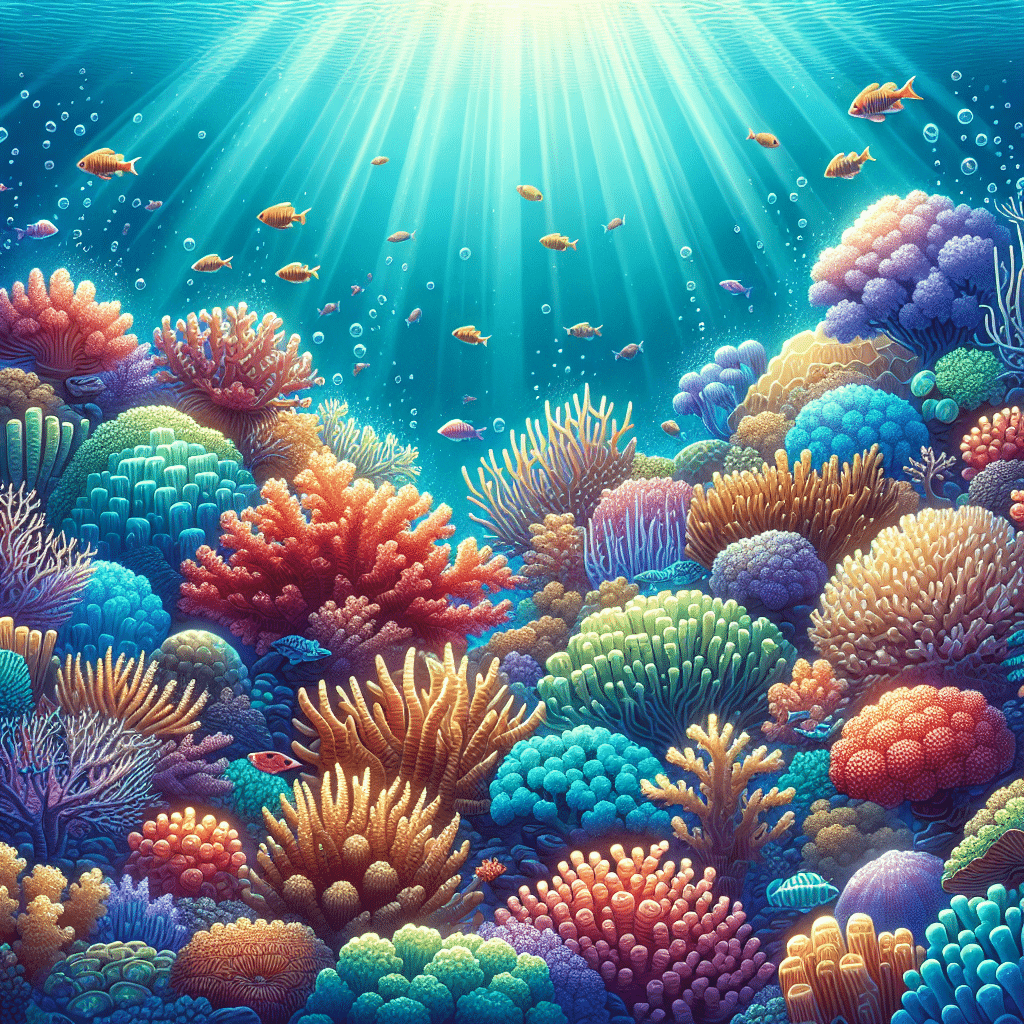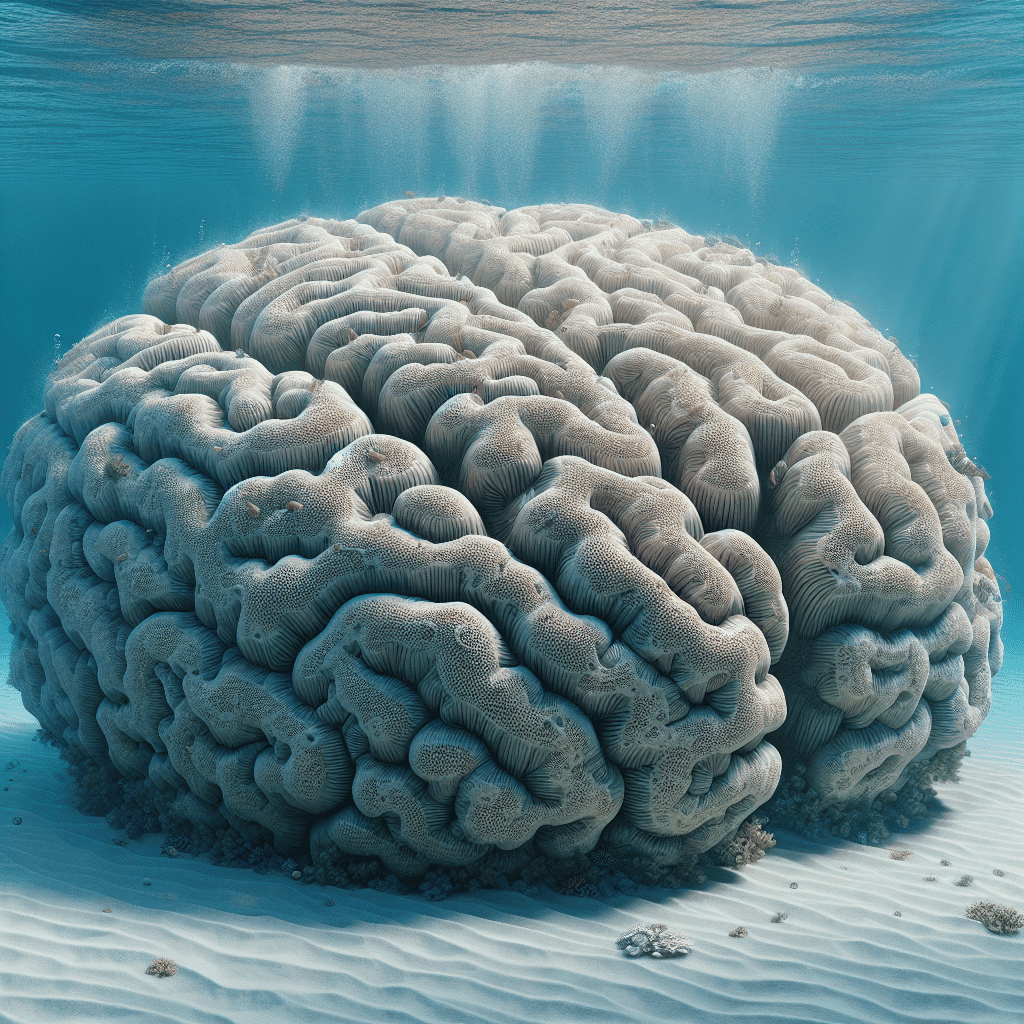Introduction to Duncan Coral
Overview of Duncan Coral
Duncan coral, scientifically known as Duncanopsammia axifuga, is a vibrant and captivating coral species that has gained popularity among reef aquarium enthusiasts. Often referred to as Branched Disc Coral, Whisker Coral, or Daisy Coral, it originates from the Indo-Pacific region, particularly Australia. This species is classified as a large-polyp stony coral (LPS) and is well-known for its striking appearance, which includes colors like green, blue, and purple (The Spruce Pets).
One of the appealing characteristics of Duncan coral is its colonial nature. It consists of multiple individual polyps that share a common skeleton, allowing them to function together as a larger colony. Each polyp has its own tentacles and mouth, contributing to the overall health and growth of the coral. The skeleton can be hard and calcareous, typically appearing white or brown (Sunny Side Corals).
Naming and Origin
The name “Duncan coral” is derived from its scientific classification, Duncanopsammia axifuga. This species has various names, including Branched Disc Coral and Whisker Coral, reflecting its unique structure and appearance. The coral is not only visually appealing but also relatively easy to care for, making it an excellent choice for both novice and experienced reef keepers.
In the aquarium trade, it is recommended to obtain Duncan coral progeny from dealers rather than wild-caught specimens. This practice helps protect natural stocks and supports sustainable aquaculture practices (Reeflex). By choosing aquacultured specimens, hobbyists can contribute to the preservation of coral populations in the wild while enjoying the beauty of this remarkable species in their tanks.
For more information on various types of corals, check out our article on corals.
Care and Maintenance
Taking care of Duncan corals can be a rewarding experience for any reef tank enthusiast. Here’s a breakdown of the essential care aspects I focus on to keep my Duncan coral thriving.
Tank Conditions
Duncan corals prefer low to moderate water movement, especially in the middle to lower parts of the tank. In lower flow areas, they tend to extend their polyps more, while stronger currents can cause them to shrink and become stressed. I’ve learned that direct, strong water flow can lead to tearing of the coral, so I aim for a gentle environment. Duncan corals aren’t the best fit for nano tanks, but they flourish in larger aquariums where they have room to spread out. For more information on coral varieties, check out our section on corals.
| Condition | Preference |
|---|---|
| Water Movement | Low to Moderate |
| Tank Location | Middle to Lower |
| Tank Size | Larger Aquariums |
Water Flow and Placement
When placing Duncan corals in my reef tank, I ensure they are situated in areas with low to medium water flow. Too much current can lead to stress and damage. I also keep an eye on the other corals around them, ensuring they have enough space to grow without competition for light or nutrients.
Feeding Requirements
Feeding Duncan corals is relatively straightforward. They benefit significantly from additional feedings, especially with amino acids, which play a crucial role in their growth and health. I often use broadcast feeding techniques to distribute amino acid solutions throughout the tank. Additionally, they appreciate occasional feedings of small zooplankton to enhance their color and growth. It’s fascinating to see visible differences in growth between colonies that are fed and those that aren’t. Regular feedings can make a big difference in their overall health.
| Feeding Type | Frequency |
|---|---|
| Amino Acid Solutions | Regularly |
| Small Zooplankton | Occasionally |
Keeping Duncan corals well-fed not only supports their health but also contributes to a vibrant and lively reef tank. For tips on the best practices, I recommend looking at our article on hammer coral and torch coral for similar care insights.
Growth and Propagation
Duncan coral is known for its rapid growth and the ease with which it can be propagated. Understanding these characteristics can greatly enhance the experience of caring for this beautiful coral in a reef tank.
Rapid Growth Characteristics
One of the standout features of Duncan coral is its ability to grow quickly. Under optimal tank conditions, these corals can develop branching shapes and form additional polyps. This rapid growth makes them an excellent choice for sustainable aquaculture and reef tank enthusiasts looking to expand their coral collection without depleting natural resources.
| Growth Feature | Description |
|---|---|
| Growth Rate | Fast-growing, capable of forming additional polyps |
| Shape | Can develop branching shapes based on conditions |
| Sustainability | Ideal for aquaculture due to easy propagation |
Propagation Techniques
Propagating Duncan coral is a straightforward process, primarily done through fragging. Fragging involves cutting a small piece of coral and attaching it to a new surface to encourage growth. Here are the steps to follow for successful propagation:
- Preparation: Gather a sharp, sterile tool to ensure a clean cut.
- Cutting: Carefully cut the coral at the base of the polyp.
- Healing: Allow the frag to heal for a few weeks. This healing period is crucial before relocating the frag to a new location.
- Attachment: Attach the healed frag to a suitable substrate in the tank.
This technique not only promotes sustainable coral keeping but also contributes to conservation efforts by reducing the need for wild coral harvesting (Sunny Side Corals, TheSea.Org).
For more information on different types of corals and their care, you can explore additional resources on corals.
Lighting and Water Quality
Ideal Lighting Levels
For Duncan coral, providing the right lighting is essential for its health and vitality. I find that these corals thrive under moderate to high lighting levels, needing about 8-10 hours of light daily. This duration helps them perform photosynthesis effectively, as they rely on the zooxanthellae living within their tissues for most of their nutrition (Sunny Side Corals). If you want to ensure your Duncan coral flourishes, consider using LED lights that can mimic natural sunlight.
| Lighting Level | Duration |
|---|---|
| Moderate to High | 8-10 hours/day |
Water Parameter Requirements
Maintaining the right water quality is just as crucial as lighting. Duncan coral prefers specific water conditions to thrive in an aquarium setting. Here are the ideal parameters:
| Parameter | Ideal Range |
|---|---|
| Temperature | 72-78°F (22-25°C) |
| pH Level | 8.1 – 8.4 |
| Salinity | 1.023 – 1.025 specific gravity |
Regular monitoring of these parameters is essential for the health and growth of Duncan corals in captivity. I have noticed that when these conditions are met, my corals not only survive but actively grow and expand. Additionally, it’s crucial to ensure the water flow is moderate. Strong currents can stress the coral, causing it to shrink and potentially tear.
By keeping a close eye on both the lighting and water quality, I can create an optimal environment for my Duncan coral, allowing it to thrive in my reef tank. If you’re interested in learning about other corals, check out corals and consider adding different varieties like brain coral or torch coral to your collection.
Appearance and Behavior
Physical Characteristics
Duncan coral, also known as Whisker Coral or Duncanopsammia axifuga, is truly a sight to behold. These corals have large polyps, each featuring a wide, flat, circular disk that typically appears in shades of light brown or green. The tentacles, which are thin and also come in brown or green, can reach a diameter of 2–3 centimeters. Each polyp has the ability to open and contract, allowing it to move captured prey toward its central mouth.
Duncan coral is a colonial species made up of many individual polyps that share a common skeleton. Its skeleton is hard and calcareous, showing off colors that can range from white to brown. This unique structure not only enhances its beauty but also plays a role in the coral’s overall health and stability in the tank. For more on different types of corals, check out our article on corals.
| Characteristic | Description |
|---|---|
| Common Name | Duncan Coral (Whisker Coral) |
| Scientific Name | Duncanopsammia axifuga |
| Polyp Diameter | 2–3 cm |
| Skeleton Color | White or Brown |
| Tentacle Color | Brown or Green |
Behavior in the Tank
In the aquarium, Duncan coral exhibits some fascinating behaviors that can add dynamic charm to your reef tank. As a photosynthetic species, it relies heavily on the symbiotic zooxanthellae living within its tissues for nutrition. However, it can also capture small particulate matter and plankton from the water column, making it versatile in its feeding habits. While they generally do not require feeding, target feeding with foods like nauplii larvae, brine shrimp, copepods, and mysis can boost their growth rates significantly (Sunny Side Corals).
Duncan corals are known for their relatively peaceful behavior and can coexist well with other corals, as long as they are placed in a suitable location. They prefer to be positioned in areas with moderate water flow and lighting, which allows their tentacles to fully extend and capture food. Their ability to open and close their polyps can also be a delightful spectacle, showcasing their active feeding and responding to changes in their environment. For more information on care specifics, visit our guide on feeding requirements.
Overall, Duncan coral not only brings stunning visual appeal to a reef tank but also offers engaging behavior that can be enjoyed by all hobbyists.
Symbiotic Relationship
Role of Zooxanthellae
Duncan coral, or Duncanopsammia, hosts symbiotic algae known as zooxanthellae within its tissues. This relationship is crucial for the coral’s survival. The zooxanthellae perform photosynthesis, providing essential nutrients to the coral in exchange for protection and access to sunlight. This process not only contributes to the vibrant colors of the coral but also plays a significant role in the energy dynamics of coral reef ecosystems (TheSea.org).
The presence of zooxanthellae means that Duncan coral receives most of its nutrition directly from these algae, making it photosynthetic. While they generally do not require additional feeding, they can also consume small particulate matter and plankton in the water column. If you’re looking to boost their growth rates, target feeding with foods like nauplii larvae, brine shrimp, copepods, and mysis can be beneficial (Sunny Side Corals).
Importance of Symbiosis
The symbiotic relationship between Duncan coral and zooxanthellae is fundamental not only for their mutual survival but also for the overall health of the reef ecosystem. This partnership allows the coral to thrive in nutrient-poor waters while providing the algae with a safe environment to live and access to sunlight.
As a colonial species, Duncan coral is composed of many individual polyps that share a common skeleton. Each polyp contributes to the collective health of the colony, and the presence of zooxanthellae enhances their ability to grow and reproduce. This symbiosis helps maintain the balance of nutrients in the reef, supporting a diverse range of marine life.
In the hobbyist setting, understanding this relationship can inform care practices for Duncan corals. Providing adequate lighting and maintaining healthy water quality are essential for supporting the zooxanthellae that, in turn, nourish the coral. For more information on the care and specifics about corals, check out our sections on corals and related species like torch coral and brain coral.
Health Monitoring
Keeping an eye on the health of my Duncan coral is crucial for ensuring it thrives in my reef tank. Here are some signs of a healthy coral and techniques I use for monitoring.
Signs of Healthy Coral
Recognizing the signs of healthy Duncan coral helps me maintain its well-being. Here are some key indicators:
| Sign | Description |
|---|---|
| Vibrant Color | Healthy Duncan coral displays bright, vibrant colors, showing that they are receiving adequate light and nutrients. |
| Fully Expanded Polyps | The polyps should be fully extended, indicating that the coral is actively feeding and thriving. |
| Stable Growth | My coral should show consistent growth over time, especially after being fed regularly. |
| Clear Water | The surrounding water should be clear, indicating that the coral is not overly stressed or decaying. |
Monitoring Techniques
To ensure my Duncan coral stays healthy, I employ several monitoring techniques:
- Water Quality Testing: Regularly test for calcium, strontium, and other trace elements essential for coral health. I keep a log of the results to track any fluctuations over time. The ideal parameters for Duncan coral include:
- Calcium: 400-450 ppm
- Alkalinity: 8-12 dKH
- Salinity: 1.023-1.025 specific gravity
Observing Feeding Behavior: I pay attention to how eagerly my Duncan coral feeds. They are one of the easiest corals to feed, and I’ve noticed significant growth differences in colonies that are fed versus those that aren’t. They thrive on amino acids and small zooplankton, so I make sure to provide these nutrients regularly (Tidal Gardens).
Light Levels: I check the lighting conditions to ensure they are low to moderate, as Duncan corals require this for optimal health. If I notice any changes in color or polyp expansion, I adjust the lighting accordingly (The Spruce Pets).
Physical Inspection: I visually inspect the coral for any signs of stress, such as bleaching or receding tissue. If I see these signs, I take immediate action to improve the water quality or feeding regimen.
By consistently monitoring these aspects, I can keep my Duncan coral healthy and vibrant. For more information on caring for other types of corals, check out articles about brain coral and mushroom coral.
Conservation and Ecosystem Health
Coral as Ocean Health Indicators
Duncan corals, like many other coral species, act as crucial indicators of ocean health. Their sensitivity to water quality and temperature makes them excellent barometers for the overall condition of marine environments. When I observe any changes in the health and appearance of my Duncan coral, it often signals shifts in the surrounding ecosystem. These shifts could be due to factors such as climate change, pollution, and ocean acidification. Monitoring Duncan corals can offer valuable insights into the state of marine ecosystems, helping hobbyists like me and researchers alike understand the effects of environmental stressors on coral health (TheSea.Org, Reef Chasers).
Environmental Impact on Coral
The health of Duncan corals is closely linked to environmental conditions. Factors such as temperature fluctuations, water quality, and pollution levels directly impact their well-being. For example, an increase in water temperature can lead to coral stress, resulting in bleaching or even death. Additionally, pollutants entering the water can disrupt their growth and reproduction. It’s essential for hobbyists to maintain optimal tank conditions to support the health of their corals. By keeping an eye on these environmental factors, I can help ensure that my Duncan coral thrives and contributes positively to the health of my reef tank (Tidal Gardens, Sunny Side Corals, Wikipedia).



